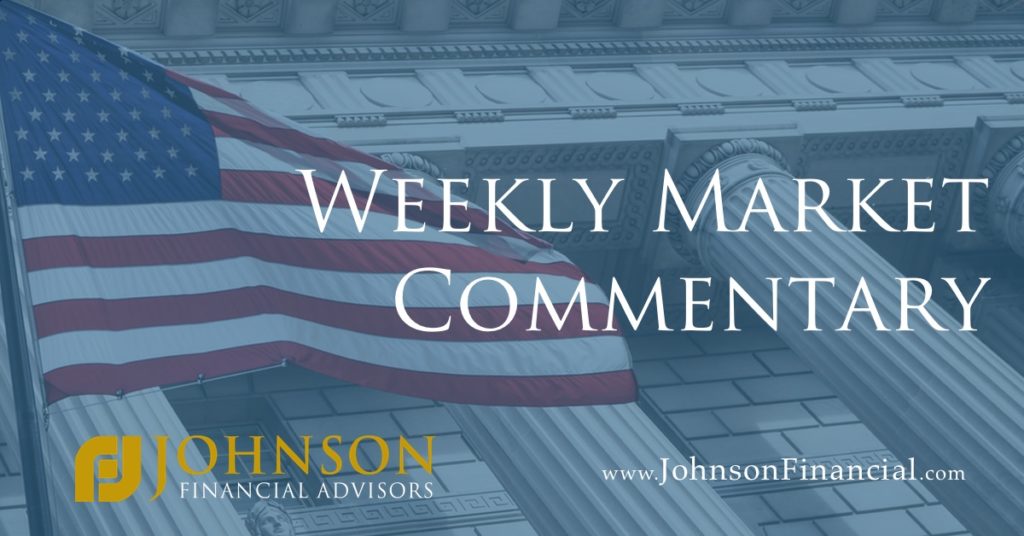
Market Commentary for the Week of September 25, 2017
For the Week of September 25, 2017
The Markets
Stocks wavered Friday amid continued threats from North Korea and concerns over the latest proposed healthcare bill. At closing, The S&P and the NASDAQ posted marginal gains while the Dow fell. For the week, the Dow rose 0.36 percent to close at 22,349.59. The S&P gained 0.09 percent to finish at 2,502.22, and the NASDAQ fell 0.33 percent to end the week at 6,426.92.
| Returns Through 09/22/17 | 1 Week | YTD | 1 Year | 3 Year | 5 Year |
| Dow Jones Industrials (TR) | 0.36 | 15.17 | 24.57 | 11.97 | 13.28 |
| NASDAQ Composite (PR) | -0.33 | 19.39 | 20.37 | 12.39 | 15.11 |
| S&P 500 (TR) | 0.09 | 13.43 | 17.33 | 10.16 | 13.76 |
| Barclays US Agg Bond (TR) | -0.15 | 3.24 | 0.31 | 2.79 | 2.16 |
| MSCI EAFE (TR) | 0.70 | 19.99 | 17.54 | 4.30 | 7.80 |
U.S. Petroleum Exports— Total petroleum exports from the United States have quadrupled over the last decade, rising from 1.3 million barrels per day in 2006 to 5.2 million barrels per day in 2016 (source: Department of Energy, BTN Research).
Quantitative Easing — In 2008, Federal Reserve Chairman Ben Bernanke announced Quantitative Easing, his revolutionary idea designed to keep the U.S. economy from falling into a 1920s-style depression. The plan involved the creation of bank reserves used to purchase bonds from American banks (source: Federal Reserve, BTN Research).
Six Years, Three Rounds — Overall, Quantitative Easing (QE) ran for six years over three programs. QE No. 1 began on Nov. 26, 2008, and QE No. 3 ended on Oct. 29, 2014 (source: BTN Research).
WEEKLY FOCUS – Four Things You Need to Know About Life Insurance
We don’t think twice about insuring our home or car against damage or loss. But 30 percent of U.S. households aren’t insured against the loss of a loved one. Why would anyone second guess the need for life insurance? It plays an integral role in most complete financial plans.
Here are some facts about life insurance you should know.
If anyone relies on you financially, you probably need life insurance. If you’re married or have children, it’s almost obligatory. But what if you’re a life partner; have an employee or business partner; or have a dependent parent, sibling or relative? Your unexpected demise will also impact their financial lives.
Life insurance doesn’t just put a monetary value on your life. It helps compensate for the financial consequences of a sudden loss of life. Adequate life insurance can eliminate the need to tap into savings or retirement funds to help pay for final expenses, outstanding loans and mortgages, educational expenses or lost income. It can help maintain a standard of living.
Life insurance is a risk management tool, not an investment. Some policies do offer an investment feature with a degree of tax privilege, but that doesn’t make them good investments. Instead, consider filling up your emergency cash reserve, paying off nonmortgage debt, maxing out your 401(k) or Roth IRA, contributing to a 529 education savings plan or setting aside money for large purchases you might expect in coming years. On the other hand, don’t assume you’re better off investing rather than buying life insurance. Until you’ve reached the breakeven point of asset accumulation, you probably need life insurance.
The death benefit may be taxed. Death benefits usually don’t incur taxes. However, there is an exception. If the insured, the beneficiary and the policy owner (whoever pays the premium) are three different people, the benefits may fall under the gift tax.
Call our office today at 602-242-4000. We can help determine how life insurance can help you secure your financial plans.
Securities America and its representatives do not provide tax advice; coordinate with your tax advisor regarding your specific situation.
Source: Morningstar.com. *Past performance is no guarantee of future results. Indexes are unmanaged and cannot be invested into directly. Three- and five-year returns are annualized. The Dow Jones Industrials, MSCI EAFE, Barclays US Agg Bond and S&P, excluding “1 Week” returns, are based on total return, which is a reflection of return to an investor by reinvesting dividends after the deduction of withholding tax. The NASDAQ is based on price return, which is the capital appreciation of the portfolio, excluding income generated by the assets in the portfolio in the form of interest and dividends. (TR) indicates total return. (PR) indicates price return. MSCI EAFE returns stated in U.S. dollars.
* The Standard & Poor’s 500 (S&P 500) is an unmanaged group of securities considered to be representative of the stock market in general. The Dow Jones Industrial Average is a price-weighted index of 30 actively traded blue-chip stocks. NASDAQ Composite Index is an unmanaged, market-weighted index of all over-the-counter common stocks traded on the National Association of Securities Dealers Automated Quotation System. The Morgan Stanley Capital International Europe, Australia and Far East Index (MSCI EAFE Index) is a widely recognized benchmark of non-U.S. stock markets. It is an unmanaged index composed of a sample of companies representative of the market structure of 20 European and PacificBasin countries and includes reinvestment of all dividends. Barclays Capital Aggregate Bond Index is an unmanaged index comprised of U.S. investment-grade, fixed-rate bond market securities, including government, government agency, corporate and mortgage-backed se curities between one and 10 years. Written by Securities America. SAI# 1437079
